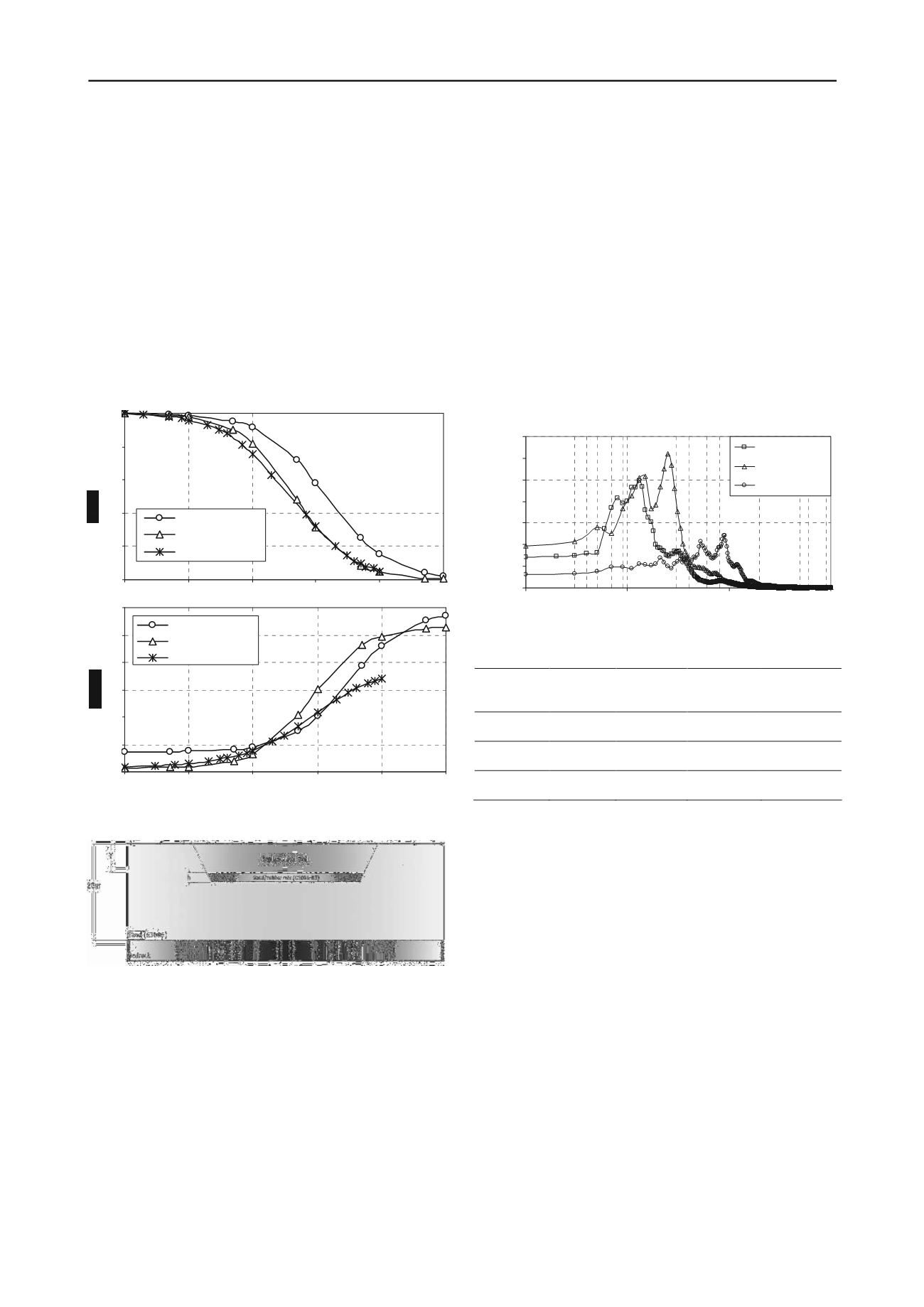
3164
Proceedings of the 18
th
International Conference on Soil Mechanics and Geotechnical Engineering, Paris 2013
reduction and damping curves of dry rubber-sand mixture
(C3D06-R3), sand (C3D06), and the replacement soil at
confining pressures (σ'
m
= 50 kPa) are shown in Figure 1. The
small strain shear modulii for the sand, RSM, and replacement
soil are 65.6 MPa, 10.4 MPa, and 234 MPa, respectively.
3 NUMERICAL MODEL
A number of two-dimensional finite element models were
built in QUAKE/W to evaluate the site response during an
earthquake. The soil was modeled using an equivalent linear
constitutive model. The baseline case representing the untreated
site condition constitutes a 20 m thick layer of sand above
bedrock. Two additional layers were inserted into the original
model to simulate replacement soil and RSM layers in the
different numerical analyses, as shown in Figure (2). The width
of the RSM layers was assumed 20m.
The effect of changing the depth and thickness of the RSM
layer and the replacement soil on top on the site response during
earthquakes was investigated. An RSM layer 1 m thick was first
assumed to be placed at depths of 1m, 2m, 4m, and 6m. The
thickness of the RSM layer was then changed to 2m, 4m, and
6m at a depth of 2m to the top of the layer.
It is important to specify the geotechnical site category that
helps us to determine the site natural period for the baseline
case which consists of 20 m of pure sand above extended base
bedrock. Site period can be obtained depending on the depth
and characteristics of the soil deposit (Bray and Rodriguez-
Marek, 1997). Because the sand soil deposit depth is greater
than 6m and less than 30m, the site is classified as "Shallow
Stiff Soil" and the site natural period will be around (0.5 sec),
(Bray and Rodriguez-Marek, 1997).
4 EARTHQUAKE GROUND MOTIONS
Three earthquake ground motions of comparable magnitude
and different frequency content were used to investigate the
ground surface layer response in case of pure sand deposit
(baseline case) and in cases of the existence of the RSM layer.
The earthquake ground motions data were obtained from the
ground motion database of the Pacific Earthquake Engineering
Research Center (PEER). The ground motion database includes
a very large set of ground motions recorded in worldwide
shallow crustal earthquakes in active tectonic regimes. Figure
(3) shows the response spectrum of earthquake input ground
motions, and Table (2) summarizes their characteristics. The
predominant period of the selected input ground motions varies
between lower than the site natural period (T
site
= 0.5 sec) such
as in Lytel Creek (T
p
= 0.08 sec) and San Francisco (T
p
= 0.26
sec), and greater than the site natural period such as in
Mammoth Lake earthquake (T
p
= 0.925 sec) in order to cover a
range of frequency contents for intermediate earthquakes.
Table (2): Earthquake ground motions characteristics
Event Name Magnitude
(M)
Peak Grnd.
Accel.
PGA (g)
Predominant
Period,
T
p
(sec)
Station
Lytel Creek
(1970)
5.33
0.070
0.130 Cedar Springs,
Allen Ranch
San Francisco
(1957)
5.28
0.095
0.260
Golden Gate
Park
Mammoth
Lake (1980)
4.73
0.031
0.925
USC Cash
Baugh Ranch
5 RESULTS AND DISCUSSION
The influence of two parameters on the site response was
studied, namely the depth of the rubber-sand mixture layer (Y)
and the thickness of the rubber-sand mixture layer (h).
A. Depth of the rubber-sand mixture layer (Y)
The numerical simulations were performed for the baseline
model (Pure sand) and for another three models in which a 1 m
thick layer of RSM were placed at depths of 2m, 4m, and 6m.
The three different input ground motions were applied to each
model. The replacement soil on top of the RSM layer was
modeled as a well compacted sand-gravel mixture layer with a
unit weight of 20 kN/m
2
. The modulus reduction and damping
curves for the replacement soil are shown in Figure 1. The
thickness of the replacement soil is the same as the depth of the
RSM layer from ground surface (Y).
The response spectra at ground surface were plotted to
investigate the effect of changing the depth of the RSM layer on
the ground response. Figure (4) shows the results for the three
earthquake ground motions. The results were divided into two
groups. The first group is for earthquake ground motions that
have a predominant period less than the site natural period (T
p
<
T
site
), i.e. Lytel Creek (1970) and San Francisco (1957)
earthquakes. The second group is for earthquake ground
motions that have a predominant period grater than the site
natural period (T
p
> T
site
), i.e. Mammoth Lake earthquake.
0.0
0.2
0.4
0.6
0.8
1.0
0.0001
0.001
0.01
0.1
1
10
shear strain (%)
RSM (35%)
Sand (C3D06)
Replacement soil
0
5
10
15
20
25
30
0.0001
0.001
0.01
0.1
1
10
shear strain (% )
RSM (35%)
Sand (C3D06)
Replacement soil
Figure 1. The modulus reduction and damping curves at (σ'm = 50 kPa)
0.000
0.005
0.010
0.015
0.020
0.025
0.030
0.035
0.01
0.1
1
10
Period (sec)
Spectral Acceleration (g)
Lytel Creek
San Francisco
Mammoth Lakes
Figure 3. Earthquake ground motions response spectrum at damping
ratio (5%)
Figure 2. The FEM model used in the numerical study


